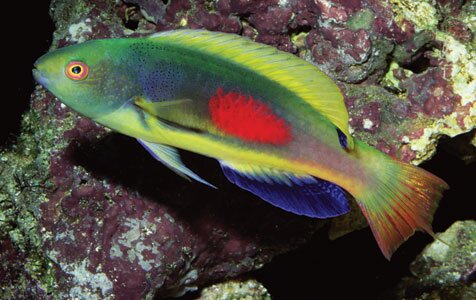Scott’s Fairy Wrasse
From Microcosm Aquarium Explorer

An attractive fairy wrasse that does best with plentiful hiding places and peaceful tankmates. Scott W. Michael
Overview
This is one of the most popular of the Cirrhilabrus in the aquarium trade. Large males are most frequently available to aquarists due to their extraordinary coloration and tendency to be hardier than some other large fairy wrasse species.
They should be placed in a tank with plenty of hiding places and may hide for a day or so before they venture out to investigate their new home. Once acclimated they can be quite boisterous and will feed aggressively on most foods.
Two male Scott’s Fairy Wrasses should not be housed in the same aquarium, unless it is extremely large (e.g., 240 gallons), and females should always be introduced before, or at least at the same time as, the male. I have found this to be one of the more aggressive members of the genus. Large males will often behave aggressively toward other fairy wrasses introduced after them, chasing them about the tank incessantly.
This wrasse is a great addition to a shallow or deep-water reef aquarium, but beware: it is notorious for jumping out of open aquariums. This species is prone to color change in captivity, especially if female conspecifics are not present.
It is not uncommon for the body to become more bluish and the red blotch on the side of Cook Island specimens to fade or disappear after they have been kept in captivity for a while.
Scott's Fairy Wrasse was named by Dr. John E. Randall in honor of Sir Peter Scott, who caught the first described specimens in the Society Islands.
See also: Variations on a Fairy Wrasse Theme.
Family: Labridae
Other common name(s):
- Scott's Wrasse
Native range:
- Coral Sea
- Fiji
- Samoa
- Society Islands
- Tuamotus Islands
- Pitcairn Group
- Great Barrier Reef
- South Pacific
Habitat: This species is usually seen in small groups in nature and are commonly found in outer reef areas.
Maximum length: 13 cm (5 in)
Minimum aquarium size: 209 L (55 gal)
Water: Marine 24 °C (75 °F) - 28 °C (82 °F)
General swimming level: Midwater to top.
Feeding
Meaty foods, including finely shredded frozen seafood, mysid shrimp, frozen preparations, pigment-enriched flake food, and Cyclop-eeze. Feed at least twice a day or preferably more often.
Aquarium Compatibility
Keep only one male per tank, and only attempt to keep a male with females in a large aquarium. The male’s color often fades if females are not present.
Special Care
Be sure to provide this wrasse with plenty of hiding places.
Notes
They often do better than some of the other larger members of this genus. They will acclimate more quickly if you keep your hands out of the tank and make sure the tank is located in a relatively quite spot.
A similar species is the Blackmargin Fairy Wrasse.








